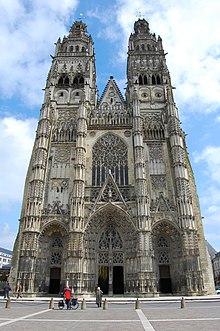Tours Cathedral
The Cathedral of Tours is a Gothic church, the holy Gatianus of Tours is dedicated, the first bishop of Tours . It is the seat of the Archbishop of Tours .
Building history
A first church was built around 338. It burned down in the 6th century at the latest and was replaced by a new, magnificent building, which Gregory of Tours consecrated in 590.
A third, Romanesque episcopal church was built in the early 12th century, but it burned out in 1166. Although it was restored, the quality of the building and the stones used was so poor that it was largely ready for demolition at the beginning of the 13th century.
The construction of a new cathedral began around 1220/1230 and was built as a basilica over the previous buildings. Around 1280 the choir and apse were completed under the direction of Étienne de Mortagne , but as early as 1267 the relics of St. Mauritius and his companions were solemnly transferred to the church. In 1465 the building was vaulted . The transept and the first two bays of the nave were built by Simon du Mans , the remaining bays by Jean de Dammartin . The north and south towers were completed in 1509 and 1507, respectively, and are 70 meters high. Both end with an octagon surrounded by four corner pinnacles with Renaissance helmets and lanterns. They were designed by the architect Pierre Valence.
Building description
The building with its almost 70 meter high towers from the 16th century was built on a slight hill to protect the cathedral from floods of the Loire . Due to the long construction period (completion of the choir in 1260, the nave around 1440), the cathedral represents all stages of development from Gothic through to the late Gothic facade, designed between 1426 and 1547 by the builders Jean de Dammartin, Jean Papin and Jean Durand . With its rich ornamentation, openwork arched fields , leaf-decorated eyelashes and archivolts with arched hangings as well as numerous pinnacles and niches, this is considered to be one of the most magnificent and richest examples of the Flamboyant style .
The spacious interior is particularly effective in the long choir, the upper wall of which appears completely dissolved by a triforium and the high colored windows in the apse, flooded with light, light and elegant. At the same time, this six-bay, five-nave and three-storey part of the cathedral with a clear height of 29 meters has monumental dimensions. The eight-bay long house is a little narrower and looks more compact.
To the north of the cathedral is the three-aisled cloister "La Psalette" (choir school).
Dimensions
- Length of the main nave: 90 meters
- Width of the main nave: 32 meters
- Height of the main nave: 29 meters
- Length of the transept: 48 meters
- Width of the transept: 10 meters
- Height of the transept: 29 meters
- Height of the north tower: 68 meters
- Height of the south tower: 69 meters
Equipment and windows
In 1562 the iconoclasting Huguenots devastated Saint-Gatien and also destroyed the portal statues , which have not been replaced to this day. 36 sculptures in the cathedral today were made by the sculptor Toussaint around 1850.
The stained glass windows represent the most remarkable part of the cathedral. The 15 splendid windows in the apse and the triforium below were inserted between 1265 and 1270. Its stained glass tells of the legends of the saints, illustrates the creation of the world and the Passion of Christ and depicts the Bishops of Tours. The rose window on the facade dates from the 15th century, that of the transept from the 14th century.
In the first southern choir chapel there is the marble high tomb (early 16th century) for Charles-Orland and Charles, sons of Charles VIII.
organ
The organ goes back in part to an instrument from 1521, from which the organ case still comes today . The instrument has been restored and expanded several times over the years, around 1762 with a Rückpositiv and an Echowerk. In 1928–1929 the instrument was completely reorganized and equipped with electropneumatic action. The last revision was made in 1992–1996 by the Strasbourg organ building company Alfred Kern & fils . Today the instrument has 56 stops on three manuals and a pedal .
|
|
|
|
||||||||||||||||||||||||||||||||||||||||||||||||||||||||||||||||||||||||||||||||||||||||||||||||||||||||||||||||||||||||||||||||||||||||||||||||||||||||||||||||||||||||||||||||
Bells
Four historical bells hang in the south tower.
| No. |
Surname |
Caster |
Casting year |
Diameter (mm) |
Weight (kg) |
Nominal (16th note) |
Remarks |
|---|---|---|---|---|---|---|---|
| 1 | Christ | N. Mutel & N. Baret | 1749 | 2850 | c 1 | Originally in the Abbey of Saint-Paul de Cormery | |
| 2 | Maurice | Bollée père et fils | 1864 | 1750 | d 1 -1 | ||
| 3 | Gatien | Bollée père et fils | 1864 | 1310 | e 1 +5 | ||
| 4th | Martin | unknown | 14th century | a 1 | |||
| I. | Clock bell | 1769 | f sharp 1 |
See also
literature
- Marianne Mehling (ed.): Valley of the Loire. Knaur's cultural guide in color. Pp. 221-224, Munich 1983.
Individual evidence
Web links
Coordinates: 47 ° 23 '44.16 " N , 0 ° 41' 40.47" E




